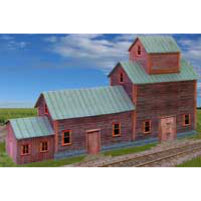Lighting a Roundhouse with Nano LEDs
Being out of the model railroad hobby for a long time, things turned around for me so that I could have a small switching/shunting layout. My main focus has been locomotive maintenance service depots, which require a turntable and a roundhouse. This article is a guide to how I lit the interior of this structure using the great products from Evan Designs.

Doing my own research and development, searching out old and new products, I happened upon the Evan Designs website. The R&D is as important as planning and gathering tools and supplies to get going and have things on hand so one can work on a project. In the old days, grain of wheat/rice incandescent bulbs wer used, which can be out of scale adn have a limited service life. So after reading that LEDs had evolved, I found that model locomotives' lighting, control panels, etc now use them as a standard in their products.
Going forward with Evan Designs, I was shocked to learn that I could power 50 of their 3V nano warm white LEDs with 2 AA batteries! Problem solved!
My roundhouse (RH) has three stalls. Following the prototype, it would require a minimum of 8 nano LEDs. (Tip: the lights in a RH do not go over the locomotives but on the sides.) So I threaded phosphor-bronze wire, 28AWG, down both sides of the RH inner walls (to the lighting buss, under the RH floor and the baseboard). I then drilled holes in the scratch-built scale lumber roof supports. This helped support the wires through the structure. At this point, four wires were running through the RH, about 1 inch apart, front and back. I soldered this to my lighting buss under the layout so I could test as I go.
I untwisted the wires, then carefully bent the nanos to a 90-degree angle and pulled the through the lamp shades (Plastruct - 95901). When I tested them, there was too much light leakage through the top of the shades, which I solved by using liquid electrical tape. This tape can also be used for layout wiring and DCC decoder installations. Using a toothpick, I dabbed a small amount on the top of the shades, which stopped the leakage and held the nanos in place. I cut the wire leads to about 1 inch and used my hobby knife to scrape off the insulation. I bent the ends into a U shape, spread the wires in a V shape, then hung them in between the support wires. This part was the most time-consuming as I had to recut the leads to make the shades level and all the same length hanging down.

I put a tiny amount of flux on the wires and hit it with an equally small amount of solder. I cut a small piece of tin foil and placed it on the floor of the RH to catch any flux/solder. I then cleaned it with contact cleaner and painted the wire insulation a flat back. Those colors are too bright for the RH! The lighting effects are wonderful!
Final notes: the nanos and plastic shades are very light! At first, they would not light, but when soldered, the connection is made. The insulation is best removed with your hobby knife and NOT your soldering iron. Using the soldering iron in this case will ruin the tip. Also, use the best batteries you can buy! I had cheap ones, and when I put them in the battery holder, the RH would not light up. I tested the batteries on my work bench on another nano, and it was very dim. New batteries - problem solved.






